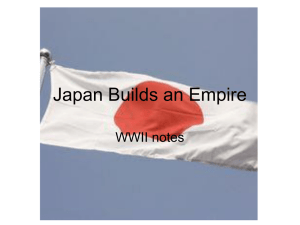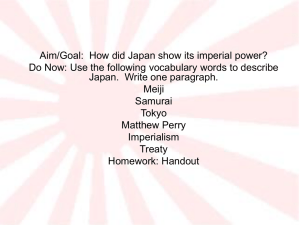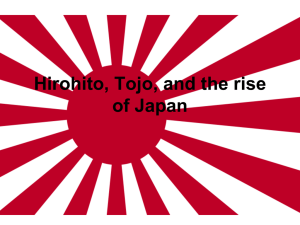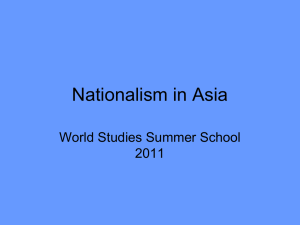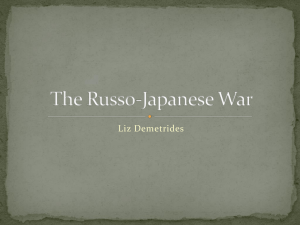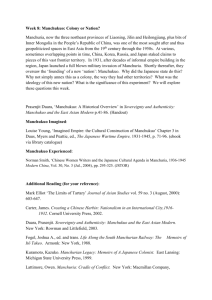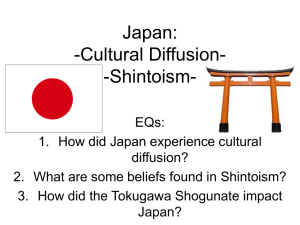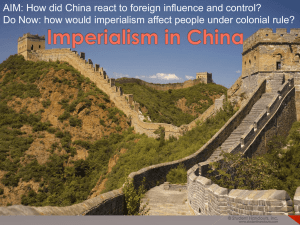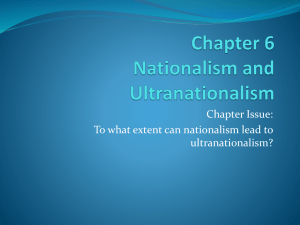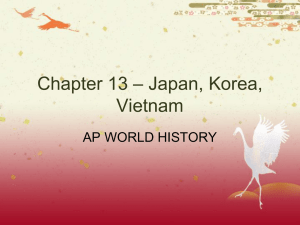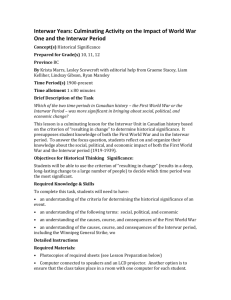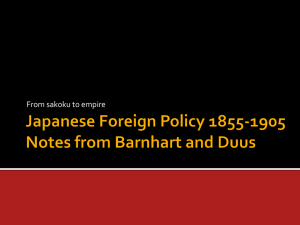The Inter-War Years * Japan
advertisement
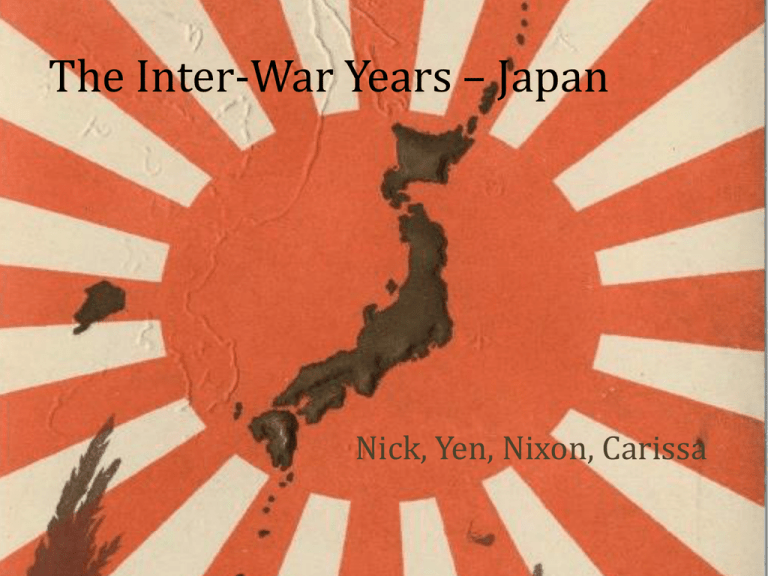
The Inter-War Years – Japan Nick, Yen, Nixon, Carissa INTRODUCTION Japan during the Meiji Period (industrialization) Before the year 1853, Japan was a very isolated country that closed its doors to foreign influence. As a result, it did not experience the modernization of Western countries that occurred during the Industrial Revolution. However, Japan opened its doors to the world in the Meiji Period from 1868 to 1912 and industrialized itself rapidly, establishing itself as a great world power by World War I. During World War I, Japan had an alliance with the British Empire, and as a result, Japan was given control of many of the Pacific islands that Germany had given up due to its defeat after the war. JAPAN’S NATIONAL INTERESTS DURING THE INTERWAR PERIOD Great Depression Japan wanted to economically compete with the European and American powers that had already established colonies in Eastern Asia. Japan needed resources to fuel their booming economy and support their growing population, which had already hit 70 million by the 1930’s. The need for resources was greater stressed during the Great Depression, when many countries reduced international trade to protect their own economic interests. Japan realized that it needed to expand its empire by claiming new territories to secure the resources needed to meet their national interests. EFFECTS ON JAPAN’S FOREIGN POLICY All of Japan’s national interests at the time led to it pursuing a foreign policy of expansionism, where Japan felt it needed more land and control over a wider area to meet its goals and fulfill its national interests. For instance, Japan was a resource poor country with a growing economy and large population. It invested large amounts of money to build the infrastructure such as railroads and the labor needed to extract and transport resources from the Chinese province of Manchuria and the Korean Peninsula to Japan. Eventually, this led the Japanese to invade and then annex both Korea and Manchuria into their empire, which created much tension between the Chinese and Japanese. They created the concept of the East Asian Co-Prosperity Sphere as their idea of complete domination over Eastern Asia, similar to the idea of the planned Greater German Reich covering most of Europe. This idea was also in Japan’s interest to eliminate the control of European powers throughout this region of the world. East Asian Co-Prosperity Sphere Poster JAPAN’S ULTRANATIONAL INTERESTS DURING THE INTERWAR PERIOD Shintoism: The emperor as a living god In the middle of the 1800’s, Japan adopted Shintoism as a state religion, which revolved around the aspect of the Emperor of Japan being a living god. The beliefs of Shintoism were used to justify the Japanese’ belief that they were superior and had the divine right to rule over the other peoples of Asia. Japan, fueled by its ultranationalist sentiments, used its powerful military to build and secure its growing empire throughout East Asia. In addition, they used to military suppression to control the cultural and social activities of the people they conquered, such as the Chinese and Koreans by assimilating them. Nationalism and Ultranationalism of Japan – 1919-1939 Nationalism: • • A sense of pride in their nation had grown in Japan after conquering other nations and supplying themselves with the resources they needed and acquiring land to gain more power Though Shintoism caused Japan to go to extremes to satisfy the needs of their nation, it also kept the Japanese closely tied with their traditions and pride as a “matchless state headed by an unbroken, inviolable, divinely descended imperial dynasty” as quoted by Shinto scholar Dr. Genchi Kato. Similarities: • • • • The Japanese people’s loyalty to their nation allowed Japan to grow and prosper. Supplied Japan with its needs satisfying their national interests Contributed to the expansionism of Japan shaping their society into what they are today All of Japan’s national interests at the time led to it pursuing a foreign policy of expansionism Ultranationalism: • • • • • Extreme decisions of Japan led to “crimes against humanity” Greater East Asia CoProsperity, a plan to make all Asian countries a part of Japan and for Japan to have full control of those countries with imperialistic ways. Caused Japan to plan fullscale invasions on other nations such as Manchuria and more of China The adoption of Shintoism made Japan ethnocentric believing that they had the divine right to rule over other Asian countries Used military suppression to control the social cultural activities of the nations they conquered Nationalism Ultranationalism This image shows Imperial Japanese troops heading to Manchuria. There is a shared sense of national pride This image displays the victory of Japan over parts of China’s land. Japan’s Expansionism Prior to the 19th century, The European and North American technologies had expanded rapidly while Japan remained an isolated nation. Eventually Japan had industrialized and modernized, growing their technology and military strength. Japan’s foreign policy had imitated that of the foreign policies of the United States and European nations. This map shows how Japan expanded over the years from 18951942 by acquiring surrounding territories during the interwar period. By acquiring more land and resources, the Japanese were able to supply their own nation with raw materials, markets and land to support its large population. Many of their national interests were met through their new foreign policy. EFFECTS OF THE GREAT DEPRESSION The Great Depression had brought a collapse of international trade and Japan was desperate for national resources. Needed materials were available in the Chinese province of Manchuria. On 18 September 1931 the Japan-built South Manchurian Railroad was bombed. The Japan used this incident and sent a fullscale invasion on Manchuria. By 1932 they controlled most of the province and its major cities renaming it Manchukuo. The Great Depression also led to an invasion of China in 1937. These incidences displays a great deal of ultranationalism where Japan showed extreme devotion to the interests of their nation, neglecting and taking advantage of the needs of other nations. Effects of World War I • Japan gained all of Germany’s Asian and eat pacific colonies. • Japan blackmailed invasion for support from China to keep their growing industrial giant going. • Chinese productions and their imports and exports slowed after the war, due to the beginnings of the Great depression. • Military status was starting to decline. WARS JAPAN FOUGHT DURING INTERWAR YEARS Sino-Japanese War: (1894) Because Japan was in great need for resources for their industrialization; the most convenient place for them to get it was Korea. Korea was had a good supply of coal and iron making it Japans target; but during this time, China wanted control of Korea too. Tension broke out between Japan and China caused the SinoJapanese war to break out in Korea. It was expected for China to win due to its strong navy. Many did not know that through industrialization, Japan had built itself up as a great military power too. After winning, Japan had a better chance of invading Manchuria without the dilemma of Chinese resistance. Japan was recognized as a rising world power through that war. WARS JAPAN FOUGHT DURING INTERWAR YEARS CONTIN. Russo-Japanese War: (1904-1905) Not only China, but Russia was very interested in control of Korea and Manchuria. Japan who was very defensive of Manchuria at the time declared war against Russia. Attacking at Port Arthur, Japan had many quick victories over Russia who was very confident in winning. The grave lost of Russia was the cause of the Russia Revolution in 1905. Defeating a European power, Japan was now really a world power. WORKS CITED World History Encyclopedia. Ed. Alfred J. Andrea and Carolyn Neel. Vol. 15: Era 7: The Age of Revolutions, 1750-1914. Santa Barbara, CA: ABC-CLIO, 2011. p661-662. Harding, Craig J. Perspectives on Nationalism. Don Mills: Oxford UP, 2009. Print. "Sino-Japanese War 1894-95." SinoJapaneseWar.com. N.p., n.d. Web. 30 Oct. 2012. The Origins of the Russo-Japanese War (1985); J. N. Westwood, Russia against Japan (1986).
